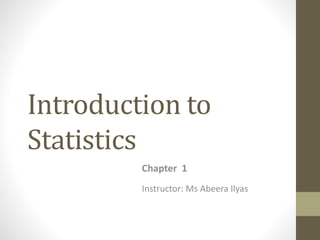
introduction to statistics
- 1. Introduction to Statistics Chapter 1 Instructor: Ms Abeera Ilyas
- 2. Meaning of Statistics • Latin word – “Status” meaning a political state originally meant information useful to state • Population size • Number of educational institutes etc • By definition – “numerical facts systematically arranged”, a commonly known synonym-data • “A discipline that includes procedures and techniques used to collect, process and analyze numerical data to make inferences and to reach decision in face of uncertainty. • “the word statistics are numerical quantities calculated from sample observations; a single quantity that has so been calculated is called a statistic.”
- 3. Characteristics of Statistics • It deals with the behavior of aggregate or large groups of data. • It deals with aggregate of observations of same kind rather than isolated figures. • It deals with variability that obscure underlying patterns. No two objects in this universe are exactly alike otherwise no statistics. • It deals with uncertainties as every process of getting observations whether controlled or uncontrolled, involves deficiencies or chance variation. • Statistics deals with those characteristics or aspects of things which can be described numerically either by counts or by measurements.
- 4. Characteristics of Statistics • It deals with those aggregates which are subject to random causes e.g height is subject to a number of causes like race, ancestry, age, diet, climate etc. • Statistical laws are valid on the average or in the long run. Inferences are therefore made in the face of uncertainty. • Statistical results might be misleading and incorrect if sufficient care in collecting, processing and interpreting data is not exercised.
- 5. Descriptive and Inferential Statistics • Descriptive Statistics: • The branch of statistics which deals with concepts and methods concerned with summarization and description of the important aspects of numerical data. It also deals with condensation, graphical displays and computation of numerical quantities that provide information about center of data (meta deta). • Inferential Statistics: • It deals with the procedures about the characteristics that describe larger group of data, called population, from the knowledge derived from only a part of data, called sample. It also includes estimation of population and testing of hypotheses. It is mostly based on probability theory.
- 6. Importance of Statistics • It assists in summarizing the larger sets of data in an understandable form. • It is helpful in the efficient design of laboratory, field experiments and surveys. • It is important for the sound and effective planning in any field of inquiry • It draws general conclusions in making predictions eg how much of a thing will happen in given circumstances. • Statistical tools are powerful for analyzing numerical data and used in every branch of learning. • It helps the administrators to draw factual basis for a decision from statistical data.
- 7. Collection of Data There are two methods for collection of data • Census: • Collection by complete enumeration of the whole field which might be too costly. • Sample: • Partial enumeration associated with a sample or limited data, it saves time and money both. Data is classified in two types • Primary data: • Data has been originally collected (raw data) and not undergone any sort of statistical treatment. • Secondary data: • Data has undergone statistical techniques at least once i-e collection, classification, tabulation or presentation in some form.
- 8. Collection of Primary data • Direct Personal Investigation: • Collection of data is done personally by investigator from individuals. The information collected is considered accurate and complete since it has been collected personally. The method is time consuming and costly but considered best for research purposes because of minimal chance of error. Personal biasness is involved. • Indirect investigation: • Third parties or witnesses having information are interviewed. The method is useful when information is complex or there is reluctance or indifference in part of informants. It can be adopted for extensive inquiries. Chance of error is present from either the witnesses or personal biasness.
- 9. Collection of Primary data • Collection through Questionnaires: • It is an inquiry form comprising of a number of pertinent questions with space for entering information asked. Usually sent by mail or delivered electronically and requested to respond in a certain period of time. The method is cheap and good for extensive inquiries. Fairly standard method for routine collection of data but the chances of error is high since the performa might be incomplete or not delivered back at all. • Collection through enumerators: • The information is gathered by employing trained enumerators who assist informants in making the entries in the schedules or questionnaires correctly. Most reliable if the enumerator is well trained and experienced. Best for large scale governmental inquiry. The process is very costly.
- 10. Collection of Primary data • Collection through local resources: • No formal collection of data but the agents or correspondents are directed to collect and send the information using their own judgments. Very cheap method but can only provide estimates.
- 11. Collection of Secondary data • Official: • Can be collected through the publications of the statistical division, Ministry of finance, The federal and provincial bureaus of Statistics etc • Semi-Official: • Information printed by semi-govt institutes eg SBP, Railway, Central cotton committee, Boards of Economic inquiry, District councils, municipalities etc. • Publication of trade associations, Chamber of Commerce. • Technical and trade journals and newspapers. • Research organizations such as universities etc